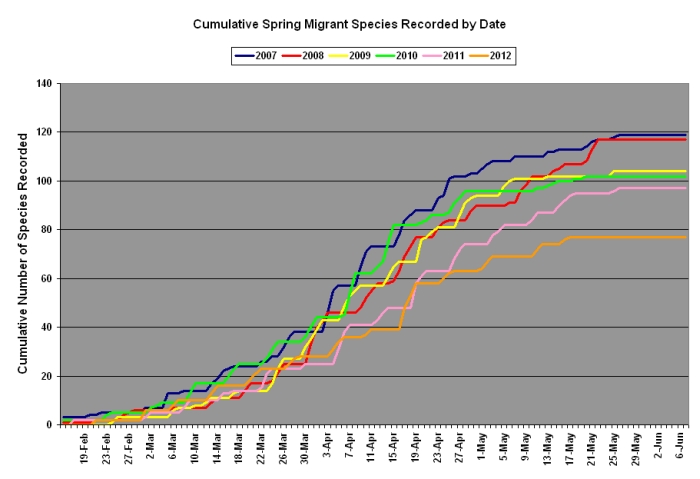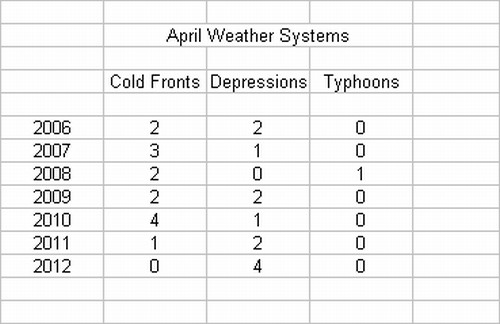I did not go to Po Toi this week – I had other things to do and I thought there would be nothing much there given the forecast of hot sunny weather. As it turned out, the wind was much stronger easterly than I expected so maybe I missed some seabirds but not landbirds.
I have been thinking about why spring and particularly April this year has been so poor. How poor can be seen from this chart showing how many spring migrant species I have seen cumulatively over each spring since 2007.

As you can see, spring 2012 started fairly normally up to the end of March but then fell away and I am now 20 to 30 species below previous levels.
Some particular species which are missing (for me) which I would normally expect to see in spring are Swinhoe’s Egret, Malayan Night Heron, Japanese Sparrowhawk, White-breasted Waterhen, Ruddy Turnstone, Common Snipe, Red Turtle Dove, Oriental and Plaintive Cuckoo, Koel, Black-capped Kingfisher, Eurasian Hoopoe, Pechora Pipit, Common Stonechat, Eyebrowed Thrush, Eastern Crowned Warbler, Mugimaki, Red-breasted and Japanese Paradise Flycatcher, Tristram’s, Yellow-browed, Yellow-breasted, Chestnut and Japanese Yellow Bunting and Purple-backed Starling. I appreciate that some of these have been seen on Po Toi this spring, but mostly only a single bird which is why I have missed it. Also, there have been no major or even small falls of Chinese Goshawk or Grey-faced Buzzard which come in April when they occur. I’ve just had two small falls of Brown Shrike in May.
So what could be the reason? The species are quite a mixed lot, Philippine and SE Asia winterers, not much clue there. There was lots of rain which is usually good for seeing migrants. I always look at the weather, particularly in spring, and I think the clue is here in this description of April 2012 given by HKO
"With the prevalence of the warm maritime airstream for most of the time except the early part of the month, April 2012 was warmer than usual… Affected by frequent passages of troughs of low pressure across the South China coast, there were also several heavy rain episodes in the month"
So, it was unusually warm with a mostly southerly airstream. There was lots of rain, but rain from depressions not cold fronts. In fact, there was not a single cold front in April 2012, which is why the month was warmer than usual.
This chart shows the number of Cold Fronts, Depressions and Typhoons in April since 2006.

There is quite a good correlation between the number of April Cold Fronts and April Species Numbers in the first chart – 2007 and 2010 were good years for April species numbers and had the most cold fronts, similarly 2011 and 2012 were poor years for April species numbers and had the least cold fronts. So it seems the number of cold fronts in April is important.
Previously I had considered cold fronts and depressions equal in their migrant effect, but clearly it is cold fronts (with rain) which are more important in April, probably because the winds with cold fronts are more northerly, so having more effect. But by May, cold fronts have mostly gone and it is depressions in May which bring in the late migrants, including small bitterns.
Don’t forget – this is not an exact science. Some cold fronts don’t cause migrants to arrive and some depressions in April are very effective (like the one just before Easter this year which gave us a good Easter). But cold fronts with rain in April are usually the most effective systems to bring us migrants, and this year we just didn’t have any.
Is the lack of cold fronts in 2011 and 2012 a chance occurrence or a result of old Nino again or a trend? – only time will tell. I’m still waiting for as good a spring on Po Toi as 2006 and 2007 – and that’s not just an old man being nostalgic about the past.
[
Last edited by wgeoff at 25/05/2012 08:05 ]


